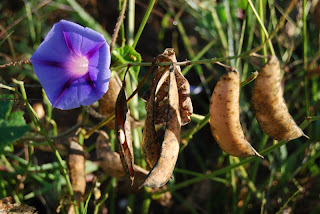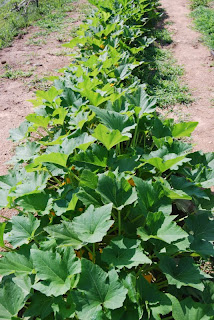Monday, March 21, 2011
The Bugs and Solutions...
The field is turned, the seed potatoes have arrived, we have all of our seeds, and we have our controls ready to go. This week we'll be planting our seeds in the greenhouse and as soon as the field is disced, we will be tilling and then planting potatoes.
Last year it was the squash bug and the bean beetle, along with the colorado potato beetle that did us in mostly. This year, we've got a bunch of controls ready to go, as well as having a much better layout for the garden, which will (hopefully) eliminate a few other problems caused by too-close planting and overhead watering.
For the squash bug: there really is no better way than to make sure there are no close cover areas for them to hide and use a "board capture" method to corral the little evil things. They gather under it at night and then you flip it over and crush em. Savage but effective. One must also hunt down the eggs and destroy them, which can be difficult, as they are on both sides of the leaves, but not impossible because the eggs are laid in neat rows and stand out against the green leaves pretty well. As this article notes, there is no substitute in the organic farming for the careful eye of the farmer: HERE.
Our tomatoes were run over with blight last year by mid-season. Part of the trouble came because we started our seeds too soon and our transplants languished in the greenhouse for too long before going in the ground. Then we planted too close together and overhead watering, coupled with the many foggy nights here in the mountains, kept the leaves wet and touching, enabling a rapid spread once the fungus took hold. There is no way to stop it once it starts but it is possible to apply bacillus subtilis in the form of Serenade to the plants at the outset with periodic reapplications and keep it at bay. You can read more HERE.
Tomatoes also get assaulted by the hornworm, which can destroy plants very quickly. To control it, and other caterpillars, we use a form of bacillus thuringensis which comes as Dipel dust, mixed in a sprayer. There are a variety of strains, and while the Dipel wasn't effective against the Colorado potato beetle, it did the job on the hornworm. More info HERE. It is not harmful to beneficial insects.
Pyrethrum, in the form of the liquid Pyganic, is a strong control for beetles, aphids, mites and the like, but it can be harmful to bees, so application timing is important to coincide when bee activity is at its lowest. It is a derivative of the chrysanthemum and provides a knockdown control, which is sometimes lacking in other organic insecticides. It can be mixed with neem/bt/etc.
We use diatomaceous earth to control ants which love to trap the aphids and make em produce "honeydew," a sweet sticky substance they find delicious.
Beneficial insects are a big help, including ladybugs, praying mantis and the trichoderma wasp. Proper mulching to control weeds eliminates hiding places and makes spotting some of these critters easier.
For further info, you can check out this organic grower's resource guide: HERE.
We'll be posting pictures of these bugs in the next post, taken last year during their attacks...not this year though!
Last year it was the squash bug and the bean beetle, along with the colorado potato beetle that did us in mostly. This year, we've got a bunch of controls ready to go, as well as having a much better layout for the garden, which will (hopefully) eliminate a few other problems caused by too-close planting and overhead watering.
For the squash bug: there really is no better way than to make sure there are no close cover areas for them to hide and use a "board capture" method to corral the little evil things. They gather under it at night and then you flip it over and crush em. Savage but effective. One must also hunt down the eggs and destroy them, which can be difficult, as they are on both sides of the leaves, but not impossible because the eggs are laid in neat rows and stand out against the green leaves pretty well. As this article notes, there is no substitute in the organic farming for the careful eye of the farmer: HERE.
Our tomatoes were run over with blight last year by mid-season. Part of the trouble came because we started our seeds too soon and our transplants languished in the greenhouse for too long before going in the ground. Then we planted too close together and overhead watering, coupled with the many foggy nights here in the mountains, kept the leaves wet and touching, enabling a rapid spread once the fungus took hold. There is no way to stop it once it starts but it is possible to apply bacillus subtilis in the form of Serenade to the plants at the outset with periodic reapplications and keep it at bay. You can read more HERE.
Tomatoes also get assaulted by the hornworm, which can destroy plants very quickly. To control it, and other caterpillars, we use a form of bacillus thuringensis which comes as Dipel dust, mixed in a sprayer. There are a variety of strains, and while the Dipel wasn't effective against the Colorado potato beetle, it did the job on the hornworm. More info HERE. It is not harmful to beneficial insects.
Pyrethrum, in the form of the liquid Pyganic, is a strong control for beetles, aphids, mites and the like, but it can be harmful to bees, so application timing is important to coincide when bee activity is at its lowest. It is a derivative of the chrysanthemum and provides a knockdown control, which is sometimes lacking in other organic insecticides. It can be mixed with neem/bt/etc.
We use diatomaceous earth to control ants which love to trap the aphids and make em produce "honeydew," a sweet sticky substance they find delicious.
Beneficial insects are a big help, including ladybugs, praying mantis and the trichoderma wasp. Proper mulching to control weeds eliminates hiding places and makes spotting some of these critters easier.
For further info, you can check out this organic grower's resource guide: HERE.
We'll be posting pictures of these bugs in the next post, taken last year during their attacks...not this year though!
Thursday, February 24, 2011
Getting Geared Up/Promised Bug Update
Won't be long now. In the next couple of weeks, we'll get our soil turned and disced, and we'll be ready to go.
More very soon including the "Bug Update" promised so many months ago.
More very soon including the "Bug Update" promised so many months ago.
Tuesday, September 28, 2010
September Update...

September was all about acknowledging the destruction the squash bugs wrought throughout the entirety of the garden. These little guys were absolutely voracious, and they spread like fog across a Blue Ridge morning, blanketing everything that was green with eggs and nymphs and then adults mating wildly.
But that didn't stop us from harvesting many delicious winter squash which we frittered and fried along with the plentiful okra which is still pouring in despite temperatures finally approaching some kind of sanity. The melons were delicious, sweet and juicy, and worth the fight. The last beans became a haven for wasps and yellow jackets and I almost fell victim to any number of black widows hiding under every log and rock.
We'll put up a "bug post" next and discuss our plans on dealing with the problems we faced come next season. We have solutions for these things, and no mercy in our farmer's hearts. That's just how we roll here.
Saturday, August 28, 2010
August Update
Well, August was a time of great successes as well as impending failures. We had more beans than we knew what to do with, a massive amount of squash and cukes (Cyn made some truly amazing pickles with some of our own hot pepper vinegar) and beautiful tomatoes before The Trouble set in. We eked out a decent little crop of onions and leeks, we saw the onset of winter squashes and pumpkins, plus the fattening up of vast amounts of melons.
August brought the Okra Avalanche, with every day requiring us to harvest a basket full of Clemson Spineless and Red Burgundy which nearly overwhelmed. Sadly, August also brought with it bugs. Lots and lots of bugs. And some diseases, like Early Blight and Fusarium Wilt. We'll have a post about the bugs and what we did right/wrong very soon. It was a dry month which presented some challenges with making sure everything got a drink, so we learned about our layout problems and will address those next season.
Overall, we're pleased with how things went, even though there was never enough time to get everything done under the searing mountain sun.
Enjoy the photos Cynthia took of the Veggie Ranch in full action:
August brought the Okra Avalanche, with every day requiring us to harvest a basket full of Clemson Spineless and Red Burgundy which nearly overwhelmed. Sadly, August also brought with it bugs. Lots and lots of bugs. And some diseases, like Early Blight and Fusarium Wilt. We'll have a post about the bugs and what we did right/wrong very soon. It was a dry month which presented some challenges with making sure everything got a drink, so we learned about our layout problems and will address those next season.
Overall, we're pleased with how things went, even though there was never enough time to get everything done under the searing mountain sun.
Enjoy the photos Cynthia took of the Veggie Ranch in full action:
Saturday, July 24, 2010
Subscribe to:
Comments (Atom)































































